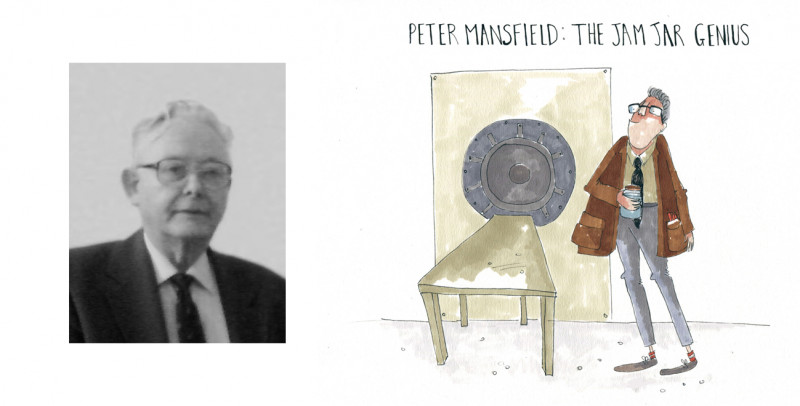By Sophie Arthur
August 1, 2018
Time to read: 4 minutes
To celebrate the pioneering scientists featured in the 2018 edition of Heroes of Health we will be writing articles about each of those featured.

Sir Peter Mansfield (1933-2017), is the third in our Heroes of Health series. Nobel laureate and MRC funded physicist, Peter revolutionised medical imaging by developing Magnetic Resonance Imaging (MRI) technology.
Born in Lambeth, London, Peter was the son of a gas fitter and left school aged 15 to work as a printer’s assistant. After developing a keen interest in rocketry, at 18 he sought a job in the Rocket Propulsion Department at the Ministry of Supply, Buckinghamshire. After just 18 months of work, he was called for national service, and went on to study A-Levels upon his return. Peter was accepted to Queen Mary College, University of London, where he studied Physics and specialised in Nuclear Magnetic Resonance (NMR), a technique for analysing chemicals.
Peter’s PhD and post-doctoral positions in NMR research eventually led to his idea of using NMR for human imaging. Peter determinedly pursued this goal for several years, working within a team of researchers at Nottingham University, and by the mid-1970s he had produced MRI images of a team member’s finger. After presenting the images, the MRC decided to support Peter and his team in funding the production of the first full-body MRI scanner.
Being the first volunteer to test the prototype MRI machine, Peter said he was ‘fairly convinced there would not be a problem.’ Despite fellow scientists warning the machine may be unsafe due to the presence of a rapidly changing magnetic field.2 Colleague Peter Morris, who now leads the Sir Peter Mansfield Imaging Centre at the University of Nottingham, wrote in Mansfield’s obituary that he, ‘personally did not believe his calculations’.1
Peter’s sheer grit and self-belief, however, led to MRI’s success. Morris spoke of Peter having ‘A brilliant and inventive mind’ and a ‘dogged determination’, character traits that were undeniably essential to his accomplishments. Peter continued working to evolve the MRI technology, most notably developing a technique named ‘Echo-planar imaging’ which drastically reduced MRI scanning times from hours to seconds. By the end of the 1980s the team had produced MRI scanners comparable to those seen in modern hospitals.3
Dr. Pawel Tokarczuk, a researcher in the MRC LMS MR Facility, worked with Peter Mansfield from 1993-95. Pawel says that he ‘learnt a lot’ from Peter, and described this period as ‘one of the busiest and most productive times of his career.’
He added, ‘Mansfield’s monument is the tens of thousands of lives saved each day from his research.’
In 2003, Peter Mansfield and Paul Lauterbur, a US scientist who also worked on developing MRI technology, were jointly awarded the Nobel Prize for Physiology or Medicine.
Today, MRI is an invaluable diagnostic tool that undoubtedly saves many lives, as well as being widely used in biomedical research such as that in the MRC LMS’s own Magnetic Resonance (MR) Facility. The MRI technology that Sir Peter Mansfield pioneered truly revolutionised and expanded the capacity of both medical diagnosis and research, saving many lives in the process.
If you’re interested in reading more about our pioneering Heroes of Health, our first feature highlighted the career of Mary Barber: Hidden hero of bacteriology and second feature highlighted the career of Almroth Wright: Icon of immunology.
References:
[1] Watts, G. (2017). Peter Mansfield. The Lancet, 389(10079), p.1602. Available at: https://doi.org/10.1016/S0140-6736(17)31009-7.
[2] Lawley, S. (2006). Peter Mansfield. [podcast] Desert Island Discs. Available at: https://www.bbc.co.uk/programmes/p0093vfn.
[3] Mansfield, P. (2018). Sir Peter Mansfield – Biographical. [online] Nobel Prize. Available at: https://www.nobelprize.org/nobel_prizes/medicine/laureates/2003/mansfield-bio.html.
By Ellie McLaughlin, Science Communications Intern, GECo.